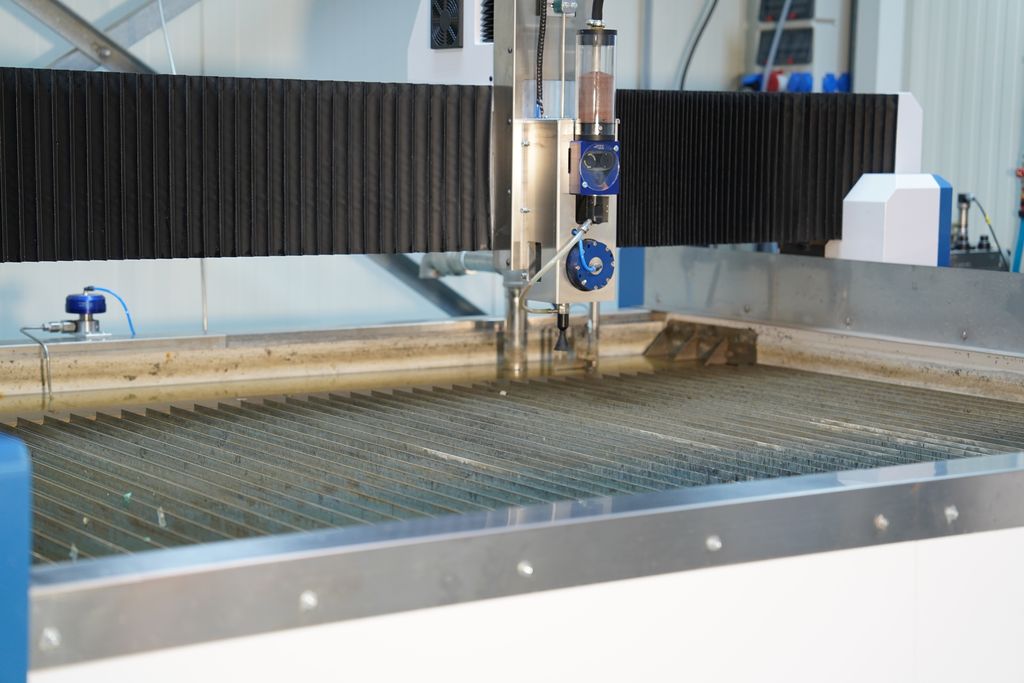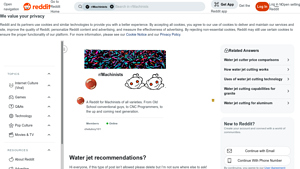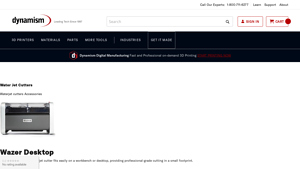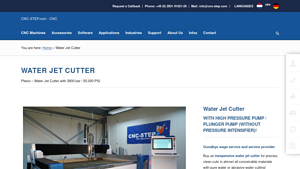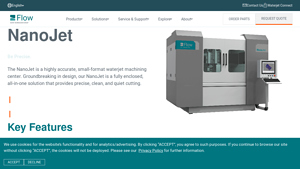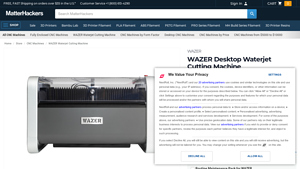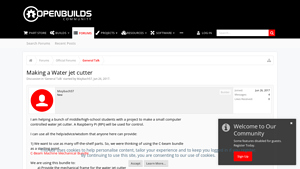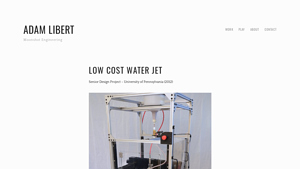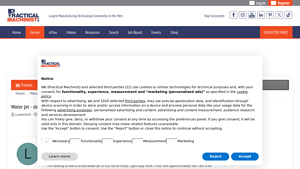Low Cost Water Jet Cutter Guide: Type, Cost, Top List…
Introduction: Navigating the Global Market for low cost water jet cutter
In the rapidly evolving landscape of precision manufacturing, sourcing low-cost water jet cutters can pose a significant challenge for businesses aiming to optimize their production capabilities while keeping costs in check. As global competitiveness intensifies, manufacturers from regions such as Africa, South America, the Middle East, and Europe—particularly buyers in emerging markets like Vietnam and Nigeria—must navigate a market saturated with options. This comprehensive guide equips B2B buyers with actionable insights on various types of water jet cutters, applications across multiple industries, and essential criteria for supplier vetting, all tailored to inform and streamline purchasing decisions.
Water jet cutting technology, known for its versatility and precision, can effectively handle a myriad of materials, from metals to ceramics. In the sections to follow, we’ll explore the distinct models available on the market, assess key performance features, and compare cost structures—ensuring that you can identify the ideal solution for your specific operational needs. By providing detailed analyses and recommendations, this guide empowers international buyers to make informed choices, ultimately enhancing manufacturing efficiency and supporting business growth in a competitive global marketplace.
Understanding low cost water jet cutter Types and Variations
| Type Name | Key Distinguishing Features | Primary B2B Applications | Brief Pros & Cons for Buyers |
|---|---|---|---|
| WAZER Desktop | Compact size, suitable for small spaces, affordability starting at $9,999 | Aerospace prototyping, small batch manufacturing | Pros: Cost-effective, easy operation; Cons: Limited cutting thickness |
| WAZER Pro | Increased thickness capacity, durable, low maintenance, starting at $18,999 | Aerospace, automotive parts, custom fabrication | Pros: Powerful, versatile; Cons: Higher initial cost |
| Plesio Water Jet | High-pressure plunger pump, suitable for thick materials, around $102,697 | Heavy machinery, stone cutting, and fabrication | Pros: Can cut thick materials; Cons: Significant investment |
| Standup Model | Space-efficient with sturdy support for materials, customizable setup | Workshops, educational institutions, manufacturing | Pros: Increased accessibility; Cons: Potentially higher overall costs |
| Integrated Systems | Combines automation and advanced cutting technology | Mass production, high precision machining | Pros: High efficiency, ideal for large operations; Cons: Complexity in setup and maintenance |
What are the key features of WAZER Desktop water jet cutters?
The WAZER Desktop is notable for its compact design, making it an ideal choice for businesses with limited space. With a starting price of $9,999, it provides an accessible entry point for those looking to incorporate waterjet cutting technology into their operations. Its capabilities are perfect for rapid prototyping and low-volume production runs, particularly in aerospace and manufacturing sectors. Businesses should consider their material thickness requirements, as the WAZER Desktop is better suited for thinner materials, which may limit its versatility.
How does the WAZER Pro stand out among low-cost options?
The WAZER Pro offers enhanced cutting capabilities, including the ability to cut materials up to 1 inch thick, making it highly suitable for more demanding applications in industries like automotive and custom fabrication. Priced at $18,999, it combines power with low maintenance, an attractive option for firms looking to invest in reliable technology. Buyers should weigh the initial investment against the potential for increased productivity and material versatility when deciding on the WAZER Pro as their waterjet cutter.
What advantages does the Plesio water jet cutter provide for heavy-duty applications?
The Plesio Water Jet Cutter features a state-of-the-art high-pressure plunger pump and is capable of cutting thick materials, including metals and stones, making it a prime choice for sectors requiring heavy machinery fabrication. However, with prices starting around €102,697, it represents a significant investment. Businesses must evaluate long-term operational efficiencies and the types of materials they commonly work with to justify this purchase.
Why should businesses consider the Standup Model in their operations?
The Standup Model is designed for flexibility, providing a sturdier setup that can hold materials securely during the cutting process. It is particularly advantageous for workshops and educational institutions where space management and accessibility are crucial. Although it may represent a higher cost, its versatility and stable design can enhance production workflows, making it a smart choice for businesses aiming to optimize their operations.
How do integrated systems compare for businesses focusing on precision?
Integrated waterjet systems combine water cutting technology with automatic features, suitable for high-precision machining and mass production applications. While these systems offer unparalleled efficiency and accuracy, which can significantly enhance productivity, they also require complex setups and ongoing maintenance. Companies focused on scaling their operations should consider these systems, keeping in mind the upfront and maintenance costs associated with them.
Key Industrial Applications of low cost water jet cutter
| Industry/Sector | Specific Application of low cost water jet cutter | Value/Benefit for the Business | Key Sourcing Considerations for this Application |
|---|---|---|---|
| Aerospace | Rapid prototyping for parts | Speeds up design iterations and reduces outsourcing costs. | Require precision cutting for lightweight materials. |
| Automotive | Custom part fabrication for vehicles | Lowers production costs while allowing flexibility in design. | Ability to cut various materials including composites. |
| Manufacturing & Metalwork | Custom jigs and fixtures | Enhances accuracy and reduces manual labor in production. | Must support cutting of thick materials and be durable. |
| Glass Art & Architectural | Intricate glass cutting designs | Automates repetitive tasks, preserving quality and detail. | Requires compatibility with various glass thicknesses. |
| Education | Teaching CNC and cutting technology | Equips students with hands-on experience in modern manufacturing. | Scalability and ease of operation for training purposes. |
How Can Low-Cost Water Jet Cutters Transform Aerospace Prototyping?
In the aerospace industry, low-cost water jet cutters are particularly valuable for rapid prototyping of lightweight components. These machines can swiftly produce functional prototypes from various materials, such as aluminum and composites, facilitating quick design iterations. This capability alleviates the burden of outsourcing, reducing both time and costs associated with traditional manufacturing methods. Buyers in this sector must prioritize precision and the ability to handle complex geometries when sourcing water jet cutting solutions.
What Are the Benefits of Custom Part Fabrication in the Automotive Sector?
The automotive sector increasingly relies on low-cost water jet cutters for custom part fabrication, enabling manufacturers to create unique vehicle components tailored to specific models. This technology allows the cutting of heterogeneous materials, such as metals and plastics used in modern cars, thus offering design flexibility while significantly lowering production costs. For international buyers, sourcing a water jet cutter that can handle diverse materials and ensure operational efficiency is crucial for maintaining competitiveness in the market.
Why Do Manufacturing and Metalwork Industries Prefer Custom Jigs and Fixtures?
In manufacturing and metalworking, low-cost water jet cutters are frequently used to create custom jigs and fixtures which enhance precision and speed in production processes. By effectively cutting intricate shapes, these machines assist in increasing accuracy, reducing human error, and minimizing manual labor. When sourcing, businesses should look for durability and the cutter’s capacity to handle thicker materials, which is essential for rigorous manufacturing processes, particularly in regions with high variability in material availability.
How Can Low-Cost Water Jet Cutters Enhance Glass Art and Architectural Designs?
For professionals in glass art and architecture, low-cost water jet cutters revolutionize the industry by automating intricate glass cutting tasks that would otherwise require significant manual effort. These machines maintain high precision in cutting complex designs, ultimately preserving the quality and aesthetic of the glass work. Buyers must ensure that their machines can accommodate various thicknesses of glass and are compatible with tools designed specifically for glass cutting, particularly important in markets where adaptability is essential.
Why Are Water Jet Cutters Beneficial for Educational Institutions?
Educational institutions benefit immensely from integrating low-cost water jet cutters into their curriculum. These machines offer students hands-on experience with advanced CNC cutting technology, enhancing their skill set for future employment in manufacturing industries. Essential considerations when sourcing include ease of operation, safety features, and the ability to handle low-volume production tasks, which allow for diverse projects in a learning environment, particularly in developing regions where educational resources may be limited.
3 Common User Pain Points for ‘low cost water jet cutter’ & Their Solutions
Scenario 1: Difficulty in Achieving Precise Cuts with Low Cost Water Jet Cutters
The Problem: Many B2B buyers, particularly in manufacturing sectors, find that low-cost water jet cutters often struggle to deliver the precision they require for intricate designs. Factors such as fluctuating water pressure, subpar software for cutting parameters, and inadequate training can significantly hinder cutting accuracy. This can result in wasted materials, increased operational costs, and delays in project timelines, ultimately affecting the bottom line and customer satisfaction.
The Solution: To overcome precision challenges, buyers should prioritize the purchase of a low-cost water jet cutter that comes with robust software designed for both beginners and experienced operators. Opting for models like the WAZER line, which include accompanying WAM software, allows users to easily set and modify cutting parameters. Furthermore, investing in employee training will ensure that staff can operate the machinery effectively, adjusting settings according to specific materials and thicknesses. Regular maintenance and calibration of the machine are also crucial. Developing a routine scheduling for these activities can significantly enhance cutting precision and ultimately improve productivity.
Scenario 2: Maintenance Costs Exceeding Initial Investment
The Problem: While low-cost water jet cutters present an appealing initial investment, many B2B buyers soon discover that ongoing maintenance, including replacements for wear parts and the cost of abrasives, can lead to unexpected expenses. This unpredictability can strain budgets, especially for small to medium enterprises that are already operating on tight margins. Buyers often find themselves caught between maintaining quality output and managing costs effectively.
The Solution: To mitigate maintenance costs, it is essential to leverage the transparency provided by manufacturers regarding consumable parts and their lifecycles. When selecting a low-cost water jet cutter, buyers should not only consider the purchase price but also conduct a thorough cost analysis of consumables over a set period. Investing in a machine that offers lower-cost, easily accessible replaced parts can maximize long-term savings. Additionally, establishing a robust maintenance program, which includes predictive maintenance techniques and regular monitoring of machine performance, will help avoid costly repairs and extend the life of the cutter.
Scenario 3: Limited Material Versatility Causing Operational Constraints
The Problem: Many users of low-cost water jet cutters quickly encounter limitations on the types of materials their machines can effectively cut. This is a significant concern in industries like automotive or aerospace, where diverse material processing is integral to production. Buyers may invest in a low-cost machine expecting versatility, only to find that it cannot handle the range of materials required—leading to compromised capabilities and the need for additional equipment.
The Solution: Before committing to a low-cost water jet cutter, it is crucial for buyers to conduct a comprehensive assessment of their material processing needs. Investigate machines capable of cutting a wide range of materials without compromising quality, and consider brands that offer extensive material compatibility. Engaging with suppliers or manufacturers to gain insights into real-world applications can be invaluable; they might provide case studies or customer testimonials demonstrating the cutter’s versatility. Additionally, consider water jet cutters that allow for customization with different nozzles and abrasive materials tailored to specific applications, thereby enhancing the range of materials that can be processed effectively.
Strategic Material Selection Guide for low cost water jet cutter
What Are the Key Properties of Aluminum for Water Jet Cutting?
Aluminum is a lightweight yet strong metal, favored in industries where weight savings are critical, such as aerospace and automotive. Its remarkable corrosion resistance enables longevity in various applications. Typically found in thicknesses ranging from 0.25″ to 1″, aluminum can be cut efficiently using low-cost water jet cutters, allowing for designs that leverage its malleability and strength.
Pros and Cons: The advantages of using aluminum include its high strength-to-weight ratio and excellent machinability, making it easier to handle, cut, and form. However, it can be expensive compared to other materials, particularly in larger quantities or when specific grades are needed. During cutting, aluminum tends to produce fine chips that can clog machinery if not managed effectively.
Impact on Applications: This material is ideal in applications demanding precision and a smooth finish, such as intricate parts for prototypes or end-use components for vehicles. Buyers must ensure they select the right grade of aluminum for their specific needs, considering factors like alloy composition and temper.
Specific Considerations: For international buyers, it’s essential to reference standards like ASTM B221 or DIN 1725 when pricing and sourcing aluminum. Some regions may offer different grades at varying costs, necessitating thorough research on suppliers.
How Does Stainless Steel Compare for Water Jet Cutting?
Stainless steel is renowned for its excellent corrosion resistance and superior strength, making it a go-to material for industries like manufacturing and construction. It is generally cut in thicknesses up to 0.5″ depending on the water jet cutter’s capabilities.
Pros and Cons: The durability of stainless steel makes it an attractive option for products destined for harsh environments. However, the material can be cost-prohibitive, especially in thick gauges; the initial investment in cutting time and abrasive materials may be higher.
Impact on Applications: The versatility of stainless steel makes it suitable for high-tolerance applications, such as intricate medical devices or durable appliances. However, its weight can be a disadvantage for applications requiring lightweight solutions.
Specific Considerations: International buyers should be familiar with standards such as ASTM A240 and JIS G4303 to ensure compliance and suitability for their local markets. Some regions also prefer specific stainless steel grades that may significantly affect cost and availability.
What Are the Advantages of Using Plastic for Low-Cost Water Jet Cutting?
Plastics, including materials like Polyethylene and Polycarbonate, are increasingly popular for water jet cutting due to their cost-effectiveness and flexibility. They typically exhibit varying strength and thickness options, making them useful in numerous applications, from packaging to components in consumer goods.
Pros and Cons: The main advantages of plastics include their low density, ease of cutting, and minimal energy requirements during the cutting process. However, they might not withstand high temperatures or pressures as well as metals, necessitating careful application selection.
Impact on Applications: Plastic can be advantageous for low-volume production and prototyping, where intricate shapes and designs might be necessary. However, buyers must evaluate the long-term durability of the plastic material, especially in outdoor or high-wear applications.
Specific Considerations: When sourcing plastic, international buyers should ensure compliance with standards such as ASTM D632 for polyethylene or JIS K6710 for polycarbonate to guarantee quality and performance. Availability may also vary based on regional supply chains.
What Are the Benefits and Challenges of Using Glass in Water Jet Cutting Applications?
Glass is another increasingly popular material for water jet cutting, valued for its aesthetic appeal and versatility in applications such as signs, décor, and functional components like kitchen surfaces.
Pros and Cons: A key advantage of glass is its ability to be cut into complex shapes without the need for costly molds. Yet, glass is brittle, which restricts its use to lower-stress applications and requires careful handling throughout the production process to avoid breakage.
Impact on Applications: Glass works excellent for precision tasks where aesthetic detail is important, though it’s less suited for structural applications. Buyers must consider that the cutting process may produce sharp edges requiring finishing.
Specific Considerations: Buyers should ensure compliance with relevant standards, such as ASTM C1048 or DIN 1249, as well as localized preferences for thickness and type. Awareness of regional regulations regarding glass safety can be critical in the Middle East and Europe.
Summary Table of Material Properties for Water Jet Cutting
| Material | Typical Use Case for low cost water jet cutter | Key Advantage | Key Disadvantage/Limitation | Relative Cost (Low/Med/High) |
|---|---|---|---|---|
| Aluminum | Aerospace components, automotive parts | Lightweight, corrosion-resistant | Higher cost compared to other materials; clogs machinery easily | Medium |
| Stainless Steel | Medical devices, kitchen appliances | Strong, durable | Higher initial cutting costs; heavier than aluminum | High |
| Plastic | Packaging, prototypes | Low density, cost-effective | Limited temperature/pressure resistance | Low |
| Glass | Décor, precision signs | Allows complex shapes, aesthetically appealing | Brittle, requiring careful handling | Medium |
This table encapsulates the essential characteristics and practical considerations for selected materials usable with low-cost water jet cutters, guiding international B2B buyers in making informed selection choices.
In-depth Look: Manufacturing Processes and Quality Assurance for low cost water jet cutter
What Are the Key Stages in the Manufacturing Process of Low-Cost Water Jet Cutters?
The manufacturing process of low-cost water jet cutters involves several critical stages, each designed to ensure that the final product meets stringent quality and performance standards. Understanding these stages helps B2B buyers evaluate potential suppliers more effectively.
How Does Material Preparation Influence Water Jet Cutter Manufacturing?
Material preparation is the first step in the manufacturing process. The primary materials used in fabricating water jet cutters typically include high-strength steel, aluminum, and various composites. Proper material selection is crucial for durability and cutting efficiency. Raw materials undergo systematic inspections to ensure they meet the necessary specifications.
In this stage, materials are often cut into manageable sizes using conventional methods before being processed further. Special attention is paid to the thickness and consistency of the materials, as these factors directly affect the machine’s capability to cut diverse materials ranging from metals to plastics.
What Forming Techniques Are Utilized in Fabricating Water Jet Cutters?
Forming is the next stage, where the prepared materials are shaped into their respective forms. This can involve techniques such as laser cutting, CNC machining, and press braking, all of which are critical in achieving the precise geometries required for water jet cutter components.
The components typically include the cutting head, pump assembly, and structural frame. For low-cost options, manufacturers often leverage automated processes to lower costs while maintaining precision. Robotics and CNC machines are frequently employed, allowing for high repeatability and consistent quality across various production batches.
How Is Assembly Handled for Low-Cost Water Jet Cutters?
The assembly phase involves the integration of all machined parts into a functional water jet cutter. Assemblers follow standardized operating procedures to ensure accuracy and efficiency. Each component is thoroughly checked against design specifications to ensure they fit perfectly and function as intended.
In many manufacturing facilities, individuals trained in lean manufacturing techniques oversee this entire process, which helps minimize waste and errors. Common practices include using color-coded tools and parts trays to reduce assembly time and improve overall productivity.
What Finishing Processes Are Essential for High-Quality Water Jet Cutters?
Finishing processes play a significant role in the durability and aesthetics of the water jet cutter. This stage typically includes surface treatments such as powder coating, anodizing, or polishing. These finishing techniques protect the equipment from corrosion and wear while enhancing its appearance.
Thorough cleaning of all parts before assembly is also critical, as it helps to avoid contamination that could interfere with the machine’s performance. Ensuring that every component is free from debris is a standard practice that often involves using ultrasonic cleaners or steam cleaning solutions.
How Do Quality Control Procedures Enhance the Reliability of Low-Cost Water Jet Cutters?
Quality Control (QC) is integral throughout the manufacturing process, providing multiple checkpoints to ensure consistency and performance. International standards such as ISO 9001 are commonly adhered to, establishing a framework for maintaining quality across the production lifecycle.
What QC Checkpoints Are Common in the Manufacturing of Water Jet Cutters?
A robust QC system typically includes specific checkpoints such as:
-
Incoming Quality Control (IQC): This involves the testing of raw materials when they arrive at the manufacturing facility. Inspector teams verify dimensions, material properties, and certifications from suppliers.
-
In-Process Quality Control (IPQC): During the manufacturing stages, operators conduct regular inspections of components to ensure they are being processed correctly. Any deviations from standards are addressed immediately, which can help mitigate costly rework later.
-
Final Quality Control (FQC): After assembly, each water jet cutter undergoes a comprehensive test cycle. This often involves running the machine to validate its performance and check for any leaks or malfunctions.
What Testing Methods Are Standard in the Water Jet Cutter Manufacturing Process?
Several testing methods are commonly employed to evaluate water jet cutters, including:
- Pressure Testing: Ensures that the cutter can handle the operational pressures required for effective cutting.
- Dimensional Accuracy Testing: Uses precision measuring instruments to verify that all parts conform to design specifications.
- Operational Testing: Involves the actual cutting of materials to assess performance, speed, and cutting precision.
How Can B2B Buyers Verify Quality Control Processes for Water Jet Cutters?
B2B buyers should be proactive in verifying the QC processes used by potential suppliers. Here are some actionable strategies:
-
Request Documentation: Buyers should ask for certification documents confirming compliance with ISO standards and other relevant industry certifications (e.g., CE marking, API).
-
Conduct Audits: On-site audits provide insights into the manufacturing practices of the supplier. Auditing key processes can reveal their commitment to quality and operational excellence.
-
Third-Party Inspection: Engaging third-party inspectors can provide an unbiased assessment of the manufacturer’s compliance with standards and practices. This can be especially useful for international transactions where standards may vary.
-
Review Quality Reports: Suppliers should provide regular quality reports, detailing any nonconformance issues and corrective actions taken. This transparency is a good indicator of a supplier’s commitment to quality.
What Unique QC Considerations Should B2B Buyers from Emerging Markets Keep in Mind?
International buyers, particularly from regions like Africa, South America, and the Middle East, must consider additional nuances when assessing QC processes. Local regulatory standards may differ from international norms, so understanding these variations is critical. Moreover, logistics and import-export regulations can impact the timely acquisition of quality materials, making it necessary to ensure that suppliers have robust sourcing strategies in place.
Additionally, the availability of technical support and after-sales service is essential for sustaining the performance of low-cost water jet cutters. Buyers should ascertain whether suppliers offer adequate training and support to optimize machine operation once they arrive on-site.
In summary, through a comprehensive understanding of manufacturing processes and stringent quality assurance practices, B2B buyers can make informed decisions when sourcing low-cost water jet cutters. By focusing on these aspects, they can ensure their investment leads to reliable and efficient cutting solutions that align with their operational needs.
Practical Sourcing Guide: A Step-by-Step Checklist for ‘low cost water jet cutter’
Introduction
This guide serves as a comprehensive checklist for B2B buyers seeking to procure a low-cost water jet cutter. With the growing demand for precision machining in various industries across Africa, South America, the Middle East, and Europe, understanding how to effectively source and evaluate water jet cutters is vital for making an informed investment.
1. Identify Your Cutting Needs
Before you begin sourcing suppliers, it’s essential to clearly define the materials you intend to cut and the thickness required. Different water jet cutters have varying capabilities, and selecting a model suited to your specific applications ensures efficiency and cost-effectiveness.
– Consider factors such as the types of materials (e.g., metals, plastics, composites) and their maximum thickness.
2. Set a Realistic Budget
Establish a budget that accounts for not just the initial purchase price, but also operational costs, maintenance, and consumables like abrasives. Understanding the total cost of ownership will provide a clearer financial picture and help prioritize features that meet your needs without overspending.
– Include potential financing options and monthly payment plans offered by manufacturers.
3. Research and Shortlist Suppliers
Compile a list of potential suppliers who offer low-cost water jet cutters. Investigate each supplier’s reputation through online reviews, industry forums, and testimonials. This step is critical to ensure that you partner with a reliable manufacturer whose products are proven in the market.
– Look for suppliers with experience in your specific industry to ensure they understand your unique challenges.
4. Evaluate Product Specifications
Carefully examine the specifications of each shortlisted model, including cutting speed, precision, and maintenance requirements. Make sure the cutter can handle the thickness of your intended materials and that it features user-friendly software for design integration.
– Pay special attention to innovations like low-maintenance designs or unique technologies that increase efficiency.
5. Request Demos and Samples
Once you have narrowed down the options, request product demonstrations or sample cuts. Evaluating the cutter’s performance firsthand will help gauge whether it meets your expectations in terms of quality and productivity.
– Consider visiting the supplier’s facility or asking for a virtual demo if travel is not feasible.
6. Verify Certifications and Warranty
Ensure that the equipment adheres to relevant industry standards and certifications, as this can significantly affect product reliability and resale value. Furthermore, check the warranty terms for the water jet cutter, as a robust warranty can mitigate potential risks associated with such investments.
– Ask for documentation related to safety certifications, energy efficiency, and material compliance.
7. Negotiate Terms and Finalize Purchase
Once you’ve selected the ideal cutter, it’s time to negotiate purchase terms. This includes prices, warranties, delivery timelines, and after-sales support. Effective negotiation can substantially impact your overall costs and service levels.
– Don’t hesitate to discuss installation assistance, training for operators, and long-term maintenance agreements with the supplier.
By following this checklist, international B2B buyers can make a well-informed decision when sourcing low-cost water jet cutters, minimizing risks, and maximizing productivity.
Comprehensive Cost and Pricing Analysis for low cost water jet cutter Sourcing
When considering the procurement of a low-cost water jet cutter, understanding the cost structure is crucial for effective budgeting. The various components that directly influence the pricing of these machines include materials, labor, manufacturing overhead, tooling, quality control, logistics, and profit margins. Each of these elements contributes to the final price you as a buyer will face.
What Are the Key Material Costs for Low-Cost Water Jet Cutters?
The materials used in manufacturing water jet cutters, specifically the components that make up the machine, play a significant role in overall costs. Quality metals, high-pressure pumps, and precision-engineered nozzles contribute greatly to the base price. For instance, high-pressure pumps like the HAMMELMANN used in some models are more expensive but offer superior efficiency and durability compared to lower-quality alternatives. Expect prices ranging from $10,000 to $20,000 for good entry-level machines, with the cost increasing based on the complexity and robustness of materials used.
How Does Labor and Manufacturing Overhead Affect Pricing?
Labor costs can vary widely depending on geographic location and the complexity of the manufacturing process. Skilled labor for precision machining is generally more expensive, elevating overall production costs. Manufacturing overhead, including utilities and maintenance of production equipment, also affects the price. Suppliers that employ lean manufacturing techniques may reduce these costs, allowing for more competitive pricing. Typically, buyers from regions with lower labor costs may find significant savings compared to those sourcing from high-cost countries.
What Role Do Tooling and Quality Control Play in Price Determination?
Tooling costs are vital for ensuring precision in cut quality, impacting not just the price of the machine but also its operational longevity. High-quality tooling extends operational life and improves cut precision, appealing to industries that require accuracy. On the other hand, stringent quality control processes may add to initial costs but can yield long-term savings by reducing waste and defects. International buyers should confirm the certifications (ISO, CE, etc.) of their suppliers to ensure compliance with local standards, affecting both price and operational capabilities.
How Do Logistics and Supplier Factors Influence the Final Cost?
Logistics costs, including shipment and handling fees, must be accounted for when determining total ownership costs. Depending on the chosen Incoterms, additional responsibilities for customs clearance and local tariffs may arise, particularly for international buyers. Understanding these clauses can mitigate unexpected expenses. Supplier reputation and reliability can also drive prices; established suppliers might command a premium for their proven track record but may provide better long-term value through after-sales support and consistent product quality.
What Buyer Strategies Can Ensure Cost-Efficiency in Sourcing?
When negotiating prices, buyers should consider different pricing models, including volume discounts for larger orders or extended payment terms that can alleviate cash flow pressures. Offering to negotiate based on long-term commitments could lower the initial price. Furthermore, calculating the Total Cost of Ownership (TCO)—including maintenance, operational expenses, and resale value—provides a clearer picture than upfront costs alone. This approach is particularly vital for international buyers from regions like Africa and South America, where logistics and service availability might vary.
What Pricing Nuances Should International Buyers Be Aware Of?
Finally, understanding the nuances of pricing in international markets is essential. Currency fluctuations can significantly affect the perceived cost advantage of sourcing from abroad. Additionally, factors like exchange rates and local regulations should inform your decision-making process. Always request quotes in your local currency and factor in all potential additional costs before finalizing your purchase.
Disclaimer: The prices mentioned in this analysis are indicative and may fluctuate based on market conditions, specifications, and supplier agreements. Always conduct thorough research and verify current costs before making procurement decisions.
Alternatives Analysis: Comparing low cost water jet cutter With Other Solutions
When considering manufacturing solutions, businesses must evaluate various options to find the most effective and efficient tools for their operations. The low-cost water jet cutter has emerged as a popular choice due to its versatility and affordability. However, it is essential to compare it with other cutting methods to make informed purchasing decisions.
Comparison Table
| Comparison Aspect | Low Cost Water Jet Cutter | CNC Plasma Cutter | Laser Cutting System |
|---|---|---|---|
| Performance | Excellent for a variety of materials up to 1″ thick | Ideal for thicker materials (up to 1″) but limited to conductive materials | Precise and fast for thin materials (<1″) but struggles with reflective surfaces |
| Cost | Starting around $9,999 | Generally $12,000 – $25,000 | Starting around $20,000, can exceed $100,000 |
| Ease of Implementation | User-friendly, minimal training required | Requires operator training for efficient use and safety | May require specialized installation and training to utilize effectively |
| Maintenance | Low maintenance, easy part replacements | Moderate maintenance; regular nozzle changes needed | High maintenance; regular servicing and lens replacements required |
| Best Use Case | Ideal for prototyping and small-to-medium production runs across diverse materials | Best for cutting metals in high volumes | Perfect for intricate designs in materials where precision is paramount |
Why Choose a CNC Plasma Cutter as an Alternative?
CNC plasma cutters are another popular choice, particularly in metalwork. They are known for their speed and ability to cut through thicker materials efficiently. However, they are primarily limited to conductive materials, and their cut quality may not match that of water jet cutting, especially on intricate designs. While the upfront cost is generally higher than that of a low-cost water jet cutter, the operational speed can lead to increased productivity in high-volume manufacturing settings.
What Are the Benefits of Using a Laser Cutting System?
Laser cutting systems shine when it comes to precision and speed. They are exceptional for detailed cuts on thin materials, allowing for intricate designs that traditional methods may struggle to replicate. However, laser cutters tend to be more expensive and are less effective on reflective or thick materials. Maintenance can also be significant, requiring stringent upkeep to maintain cut quality. Buyers must weigh the higher initial investment against the potential productivity benefits in industries where speed and precision are crucial.
Conclusion: How to Choose the Right Cutting Solution for Your Needs?
Selecting the right cutting technology requires a comprehensive analysis of your unique operational needs. Consider the materials you will be cutting, the production volume, and your budget constraints. If your priority is versatility and affordability, a low-cost water jet cutter may be the best fit. However, industries focused on metalwork or precision designs might find that CNC plasma or laser cutting systems provide better solutions, despite the higher costs and maintenance requirements. Engaging with suppliers for demos and consulting with industry experts can further aid in making a well-informed decision tailored to your business objectives.
Essential Technical Properties and Trade Terminology for low cost water jet cutter
What Are the Key Technical Properties of a Low-Cost Water Jet Cutter?
When selecting a low-cost water jet cutter for industrial use, understanding its technical properties is crucial. Here are critical specifications that significantly influence performance and productivity:
-
Cutting Pressure (PSI)
– Water jet cutters operate at high pressures, typically ranging from 30,000 to 55,000 PSI. This specification determines the cutter’s ability to penetrate various materials effectively, from metals to composites. Higher pressures allow for cutting thicker materials and achieving smoother finishes. For businesses, this can translate into reduced processing time and costs. -
Cutting Thickness
– The maximum thickness the machine can cut is a vital metric. Most low-cost water jet cutters can handle materials of varying thicknesses, such as up to 1 inch for aluminum or 0.375 inches for steel. Understanding this allows businesses to ensure they select a machine capable of meeting their specific project demands without outsourcing, reducing lead times and costs. -
Material Compatibility
– A versatile water jet cutter should be able to cut through a diverse range of materials, including metals, plastics, glass, and ceramics. Knowing the compatibility helps businesses prepare for various applications—from manufacturing parts for machinery to prototyping for design. This flexibility can optimize production capabilities and tailor outputs to client requirements. -
Accuracy and Tolerance
– Water jet cutters often achieve cutting tolerances between 0.005 and 0.010 inches, essential for industries requiring high precision, such as aerospace or automotive. This specification directly impacts product quality, reducing the need for secondary processes such as sanding or finishing, thereby saving time and costs in production. -
Maintenance Requirements
– Understanding the maintenance needs, including wear parts and water quality, can help in calculating total cost of ownership. Low-maintenance water jet cutters, like the WAZER Pro, minimize downtime and ongoing expenses, making them ideal for budget-conscious buyers seeking reliable long-term operations. -
Footprint and Size
– The physical dimensions of a water jet cutter influence its usability within a workspace. Low-cost options, like the desktop models, are designed compactly for easy integration into small workshops or production facilities. This allows businesses to maximize their workspace without compromising capabilities.
What Are Common Trade Terms Related to Low-Cost Water Jet Cutters?
Familiarity with industry jargon can facilitate smoother transactions and negotiations. Below are key trade terms:
-
OEM (Original Equipment Manufacturer)
– This term refers to companies that produce parts or equipment that may be marketed by another manufacturer. For B2B buyers, understanding OEM relationships can lead to better pricing and reliability in sourcing replacement parts or consumables for their water jet cutters. -
MOQ (Minimum Order Quantity)
– MOQ indicates the smallest amount of product a buyer can order from a supplier. For low-cost water jet cutter components or consumables like abrasives, knowing the MOQ can affect budgeting and inventory management, especially for smaller companies planning initial purchases. -
RFQ (Request for Quotation)
– An RFQ is a formal process where potential buyers request a quote from suppliers for specific products or services. Understanding how to craft an RFQ for water jet cutters can optimize procurement efforts and ensure competitive pricing. -
Incoterms
– These are international commercial terms that define the responsibilities of buyers and sellers involved in shipping goods. They govern aspects like shipping costs and liability, which can significantly affect the total cost of acquiring a water jet cutter from overseas manufacturers. -
Lead Time
– Lead time refers to the amount of time from the placement of an order to the arrival of the product. Knowing lead times for water jet cutter deliveries is crucial for planning production schedules and inventory levels. -
Cutting Head
– The cutting head is the part of the water jet cutter where the water and abrasive are mixed and expelled to perform cutting. Understanding variants in cutting head designs and capabilities can help buyers select a machine that meets their specific cutting needs, such as for intricate designs.
These technical specs and trade terms equip B2B buyers with the knowledge to make informed decisions, ensuring they choose the right low-cost water jet cutter for their operational needs.
Navigating Market Dynamics and Sourcing Trends in the low cost water jet cutter Sector
What Are the Key Drivers of the Low-Cost Water Jet Cutter Market?
The low-cost water jet cutter market is being shaped by several global drivers, mainly the growing demand for precision cutting across diverse sectors. Industries including aerospace, automotive, and manufacturing are increasingly adopting water jet technology due to its versatility in cutting various materials—from metals to plastics and composites. This trend is especially pronounced in developing regions of Africa, South America, and parts of Europe, where manufacturers seek cost-effective solutions to enhance production capabilities.
Technological advancements are also influencing market dynamics, enabling the introduction of smaller, more affordable systems that provide industrial-grade performance. For instance, models like the WAZER Desktop have lowered entry barriers for small to medium enterprises (SMEs). These devices are suitable for standard workshop environments without the need for extensive infrastructure, appealing particularly to markets in places like Vietnam and Nigeria where capital expenditure can be a concern.
Additionally, environmental regulations and the push for sustainable manufacturing practices are causing businesses to explore water jet cutting as a more eco-friendly option compared to traditional methods. Greater awareness of cost efficiency and reduced waste during the cutting process solidifies water jet technology’s footprint in the global market.
How is Sustainability Influencing the Sourcing of Low-Cost Water Jet Cutters?
Sustainability has become a pivotal concern for B2B buyers in the low-cost water jet cutter sector. The environmental impact of manufacturing processes drives companies to make ethical sourcing choices—highlighting the importance of working with suppliers that prioritize sustainable practices. Low-cost water jet cutters utilize water and abrasives rather than chemicals, reducing harmful emissions and waste, making them a cleaner option for cutting.
Furthermore, the push for compliance with international sustainability standards and the importance of green certifications are motivating a shift in buyer behavior. Organizations are prioritizing partnerships with manufacturers that can demonstrate sustainability credentials, such as sourcing eco-friendly materials or using energy-efficient products.
In emerging markets, the adoption of water jet technology can also lead to reduced dependence on outsourcing and promote local manufacturing. Companies can minimize the carbon footprint associated with transporting materials and products by developing in-house cutting capabilities with water jet technology, creating a win-win situation for both the environment and local economies.
What is the Historical Context Behind the Evolution of Water Jet Cutting Technology?
Water jet cutting technology has roots dating back to the 1930s when it was first used for mining. However, its significant development began in the 1950s with the idea of boosting cutting efficiency using high-pressure water jets. As pressure technology advanced through the decades, the use of abrasives to enhance cutting capabilities gained traction, allowing for the slicing of harder materials.
The 1980s saw the introduction of computer numerical control (CNC) technology for water jet cutters, leading to a new era of precision and customization. This evolution paved the way for smaller, more affordable models, enabling greater accessibility for businesses in diverse markets. Today, with a combination of affordability, efficiency, and minimal environmental impact, water jet cutters are essential tools for industries across the globe, facilitating innovation and rapid prototyping in a cost-effective manner.
This evolution reflects broader trends within the manufacturing sector toward automation, efficiency, and sustainability—crucial attributes that resonate with modern B2B buyers seeking innovative solutions that align with their business goals and social responsibility.
Frequently Asked Questions (FAQs) for B2B Buyers of low cost water jet cutter
1. How do I choose the right water jet cutter for my needs?
Choosing the right low-cost water jet cutter involves assessing your specific cutting requirements, such as material type, thickness, and volume of production. Review the cutter’s capabilities, including its cutting speed and precision. It’s also vital to consider the total cost of ownership, which includes maintenance, running costs, and consumables like abrasives. As international logistics can affect delivery times and costs, ensure the supplier can ship efficiently to your location. Finally, inquire about demo options to see the cutter in action before making a commitment.
2. What are the key benefits of using a water jet cutter in my business?
Water jet cutters provide several advantages, including versatility, as they can effectively cut a wide range of materials, such as metals, glass, and plastics. They offer precision cutting, which reduces waste and improves product quality. Moreover, water jet cutting is cold, minimizing thermal distortion in heat-sensitive materials. Choosing a low-cost option allows small to medium enterprises to access this advanced technology without significant capital investment, promoting in-house production and quick turnaround times.
3. How can I vet suppliers of low-cost water jet cutters?
Vetting suppliers is essential for ensuring quality and reliability. Start by checking their reputation online through reviews and testimonials from other businesses. Request references and follow up with their previous clients to assess satisfaction levels. Evaluate the supplier’s certifications and history in the industry, and consider their response times and customer service approach. Finally, verify their ability to provide local support and after-sales service, which is crucial for minimizing downtime.
4. What customization options are available for water jet cutters?
Many suppliers offer customization options to cater to specific production requirements. Customization may include tailored software interfaces, specific size adaptations for your workspace, or unique tooling suitable for particular materials or cutting processes. Inquire about the available modifications during your discussions with potential suppliers, as this could significantly enhance your production efficiency and quality.
5. Are there minimum order quantities (MOQ) for purchasing water jet cutters?
MOQs can vary significantly based on the supplier and your individual order requirements. Some manufacturers may not have a MOQ for water jet cutters, while others might require the purchase of consumables or accessories bundled with the cutter. It’s important to clarify MOQ details up front, especially if working on a tight budget that limits upfront investment. This ensures you can negotiate a purchase that aligns with your production needs and budget constraints.
6. What payment terms are typical when buying a low-cost water jet cutter?
Payment terms can vary based on the supplier’s policies and your negotiation power. Common arrangements may include upfront payments, financing options, or monthly installment plans. Some suppliers may offer leasing options or require a deposit with the remaining balance due upon delivery. Always negotiate payment terms that work for your cash flow while ensuring the supplier’s credibility before proceeding with larger orders.
7. How can I ensure quality assurance (QA) for my water jet cutter?
Ensuring quality assurance involves several steps. Look for certifications such as ISO standards, which indicate a commitment to quality management. Request detailed specifications and performance guarantees from suppliers to ensure the cutter meets your requirements. It’s also advisable to discuss the testing procedures the supplier implements before shipment. Furthermore, verify warranty terms and after-sales support to address any issues that may arise post-purchase.
8. What logistics considerations should I keep in mind when sourcing water jet cutters internationally?
When sourcing internationally, consider shipping costs, customs duties, and potential delays in delivery times. Ensure your supplier has experience navigating international logistics to provide clear information on lead times. Check if they offer shipping insurance to protect against damages during transit. Additionally, familiarize yourself with your country’s import regulations and standards for industrial machinery. A reliable logistics partner will ensure a smooth process from supplier to your facility, avoiding costly disruptions.
Important Disclaimer & Terms of Use
⚠️ Important Disclaimer
The information provided in this guide, including content regarding manufacturers, technical specifications, and market analysis, is for informational and educational purposes only. It does not constitute professional procurement advice, financial advice, or legal advice.
While we have made every effort to ensure the accuracy and timeliness of the information, we are not responsible for any errors, omissions, or outdated information. Market conditions, company details, and technical standards are subject to change.
B2B buyers must conduct their own independent and thorough due diligence before making any purchasing decisions. This includes contacting suppliers directly, verifying certifications, requesting samples, and seeking professional consultation. The risk of relying on any information in this guide is borne solely by the reader.
Top 8 Low Cost Water Jet Cutter Manufacturers & Suppliers List
1. OMAX – ProtoMAX Waterjet
Domain: reddit.com
Registered: 2005 (20 years)
Introduction: ProtoMAX waterjet by OMAX is recommended for small parts, but has caveats: pump seals may dry up and fail if used intermittently, requiring annual pump rebuilds; axis motors may fail, but are replaced by OMAX at no cost; incoming water supply should be filtered; avoid buying garnet through OMAX due to high prices (Barton 80HPA is cheaper); keep extra nozzle bodies and mixing tubes on hand. Waterje…
2. Dynamism – Water Jet Cutters
Domain: dynamism.com
Registered: 1997 (28 years)
Introduction: {“Water Jet Cutters”: {“Wazer Desktop”: {“price”: “$9,999.00”, “description”: “Professional-grade waterjet cutter that fits on a workbench or desktop.”}, “Wazer Standup”: {“price”: “$10,999.00”, “description”: “Standup model for powerful waterjet cutting in a shop with a sturdy leg system.”}, “Wazer Starter Bundle”: {“price”: “$11,999.00”, “description”: “Includes WAZER Standup, 2,200 lb Pallet of…
3. CNC-Step – Water Jet Cutter Plesio
Domain: cnc-step.com
Registered: 2005 (20 years)
Introduction: Product: Water Jet Cutter Plesio
Pressure: Up to 3800 bar (55,000 PSI)
Cutting Thickness: Up to 150 mm (potentially 200 mm)
High-Pressure Pump: Plunger pump from HAMMELMANN®
Efficiency: Up to 36% better than pressure intensifier pumps
Flow Rate: 2.0 to 4.0 L/min
Motor Options: 15 kW and 30 kW drive motor versions
Warranty: 24 months or 2000 operating hours
Cutting Method: Underwater cutting
Materi…
4. Flow Waterjet – NanoJet Precision Cutting System
Domain: flowwaterjet.com
Registered: 2003 (22 years)
Introduction: NanoJet is a highly accurate, small-format waterjet machining center that features a fully enclosed, all-in-one design for precise, clean, and quiet cutting. It is optimized for high output operations while utilizing minimal floor space. With capabilities for both precise cutting and rapid part production, the NanoJet is suited for cutting highly engineered materials requiring precision and comple…
5. WAZER – Desktop Waterjet Cutting Machine
Domain: matterhackers.com
Registered: 2012 (13 years)
Introduction: {“Product Name”: “WAZER Desktop Waterjet Cutting Machine”, “Manufacturer”: “WAZER”, “Category”: “CNC Machines”, “Key Features”: [“Utilizes advanced technology for accurate results”, “Compact and contained machine”, “Compatible with any size workshop”, “Cuts any hard and soft materials”, “Waterjet cut at a fraction of the cost”, “Quick Learning Curve”, “Flexible Free-standing Option with Standup Ac…
6. OpenBuilds – C-Beam Machine Mechanical Bundle
Domain: builds.openbuilds.com
Registered: 2012 (13 years)
Introduction: C-beam machine mechanical bundle used for the mechanical frame and motor control for x, y, z axis; concerns regarding cost and suitability for water jet cutting; intended to use off-the-shelf parts; plans for a plexiglass enclosure around the cutting area; project aimed at cutting materials like styrofoam, light wood, or plastic; safety features under consideration for pressure control; suggestion…
7. Adam Libert – Low-Cost Waterjet Cutter for Hobbyists
Domain: adamlibert.com
Registered: 2013 (12 years)
Introduction: Low-Cost Waterjet Cutter designed for hobbyists and small businesses; cutting work space of 12″x14″; self-contained footprint of 2ft x 2ft; requires typical electrical outlet and shop air; budget of $5000 or less; low maintenance; minimal training required; cuts 1/4″ aluminum and 1/8″ steel to a tolerance of 0.005″; project won Mechanical Engineering Senior Design competition; developed as WAZER.
8. Maxiem – 1515 Water Jet System
Domain: practicalmachinist.com
Registered: 2000 (25 years)
Introduction: Water jet – single phase, cut size approximately 48″x48″; intended for light duty work; user is looking for an electric system; needs compatibility with single phase power; mentions potential power requirement of at least 10kW; interested in models like Maxiem 1515 but uncertain if it can be adapted to single phase; exploring manufacturers like OMAX; user has a 200 amp single phase panel available…
Strategic Sourcing Conclusion and Outlook for low cost water jet cutter
Investing in low-cost water jet cutters presents a unique opportunity for businesses in diverse industries such as aerospace, automotive, and manufacturing. By embracing strategic sourcing practices, B2B buyers can identify versatile, cost-effective solutions like the WAZER Pro or other budget-friendly models that accommodate a broad range of materials—from metals to ceramics. Highlighting their operational efficiency and low maintenance requirements, these tools not only reduce outsourcing costs but also enhance production capabilities.
Moreover, with the rise in localized production and the necessity for rapid prototyping, water jet cutters empower businesses in emerging markets, including those in Africa, South America, the Middle East, and Europe. Organizations can respond to market demands swiftly while ensuring quality and precision in their output.
As you consider your next investment, prioritize understanding supplier capabilities and reviews to make informed decisions. The future of manufacturing is heading towards greater accessibility and efficiency through advanced technologies like water jet cutting. We encourage international buyers to explore customized demos and gather comprehensive insights before committing. Equip your business with the right tools to stay competitive and innovative. Your journey towards streamlining production starts with the strategic choice of a water jet cutter today.

